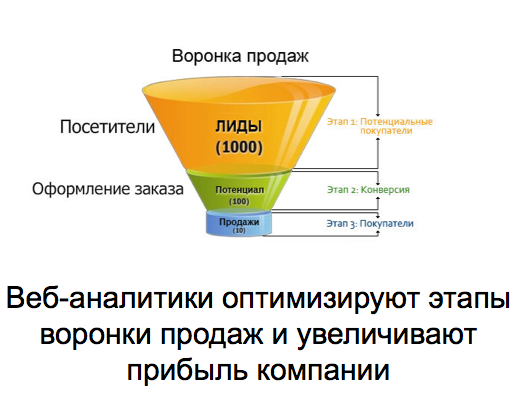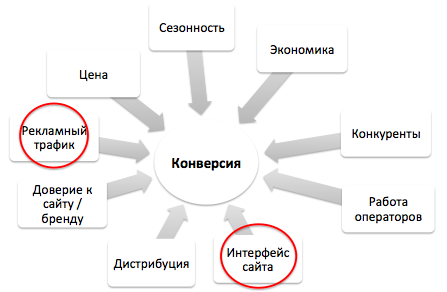Web analytics: why does your business need it?
“Web analytics opens up unlimited possibilities for optimizing and improving not only the site, but also the company's business processes” - COO 1download , Sergey Artemyev.
What do online stores lose when e-commerce is not configured? What are missing sites for services that do not have integration with call-tracking? So, what does a site lose or lose in the absence of analytics?
Consider the three most common situations that are most commonly found on the market.
1) There is no analytics system at all, or it is configured incorrectly.
Most companies do not collect data at all, and if they do, they are often wrong or not in full, which is actually equivalent to the first case. Even if the online store uses Google Analytics, but it is not configured, it is extremely difficult to draw conclusions that are really useful for business from these obtained data. Data is simply not enough.
2) Analytics is, but there is no one to analyze
Another case is when all analytics systems are set up, but the company lacks professional employees who can competently analyze these data and draw useful conclusions. There are not enough strong personnel in the market, and not all companies are ready to keep an analyst on staff.
')
3) One-time analytics for some tasks or projects
The third option is when a company needs one-time analytics services, for example, to audit an advertising campaign in order to verify a contractor how well he fulfills his obligations.
There is a huge variety of analytics systems, but in 90% of cases Google Analytics and Yandex Metrics are enough. Only for very specific business areas and tasks may require some kind of specialized analytics systems.
For example, Google Analytics can be used for mobile applications, it can track mobile traffic, there you can also set up goals and events, but this is still an incomplete analytics system. Such systems as Kissmetrics, Flurry, MixPanel will come to the rescue.
The Yandex.Metricka web browser does an excellent job with its task - it shows the actions of visitors on the site, but there are specialized systems for tracking user behavior that have much more functionality.
Web analytics features
The capabilities of analytics systems are essentially limitless and they can be used in a wide variety of business areas for a variety of tasks. For example, employees of one company that develops data processing algorithms have figured out how to select a neighborhood of passengers in an airplane based on data from social networks, purchase histories, etc. They tested their algorithm on a real flight. Upon completion of the flight, the flight attendants filled out a questionnaire, and it turned out that it was the most talkative flight of all time. For the airline, the commercial interest of such analytics is to form a loyal audience and increase revenue from the sale of alcohol and souvenirs on board.
But more often site owners want to increase either the number of incoming calls or the conversion into sales from these calls.

In this case, the conversion is affected by many factors. But the analyst can only affect two of them:

Thus, one of the areas for analytics can be working with site usability. For example, behavioral analysis is aimed at improving advertising campaigns: we understand how users behave when they come to the site from a certain advertising channel, what they did on the site, and what prevented them from buying a product or service. Based on the data obtained, recommendations can be made, for example, on the improvement of the interface. Then hypotheses are built, changes are implemented and tested.
A cohort analysis is useful for evaluating advertising campaigns with a deferred effect - this is one of the ways to segment an audience and process data across different segments.
Analytics for online store
The most important thing for an online store is to be able to track traffic efficiency in the context of final orders. The main solution in this case is E-commerce in Google Analytics, which allows you to track all orders made from the site. The analytics system records the order code, date, traffic source (advertising, SEO, etc.), the amount of the order, the amount of goods in the cart, the path that the client traveled before the order, etc. Thus, it becomes possible to evaluate and compare different advertising campaigns.

What does this give? First of all, it is possible to evaluate how effective paid advertising channels are. Knowing advertising costs in Yandex.Direct, the number of orders received and the average bill, you can, for example, calculate the ROI and determine whether this advertising channel pays off or not. But the estimation by traffic sources is only the topmost level.
By digging deeper, you can see which keywords lead to sales. According to the experience, 80% of keywords from all advertising campaigns on the market do not contribute to sales at all. With the help of analytics, you can identify those 20% of keywords that affect direct sales, and greatly reduce advertising budgets, while maintaining efficiency. But not everything is so simple, it is always necessary to take into account the interconnection of channels (“associated conversions”).
The path of the user from the first visit to the site is very long. Rarely when a client comes for the first time from an advertisement and immediately buys something on the site. This is usually a longer chain: the visitor came to the site through contextual advertising, returned through the search, then entered from the mobile device on the product card, which he had postponed, and made the order from the stationary PC directly by entering the site. Turning off one of the channels, even if it does not bring sales here and now, we risk breaking this chain. And all this data can and should be analyzed. In terms of web analytics, this is called "multichannel sequences."

To assess the impact of the traffic channel on sales, there are so-called "Attribution models". For example, the site has three channels of traffic: contextual advertising, SEO and banner advertising. Each channel has a different effect on sales. For example, banner advertising does not bring direct conversions, but in 50% of cases it participates as a source of customer persuasion for the final sale. Without it, this chain will break, and sales, for example, in the context will fall. When assessing the cost of attracting a client and the cost of conversion, one can take into account the effect of the channels, taking into account various factors. The presence of all these data and a specialist who will regularly monitor and analyze them, will allow you to properly configure the effective interaction of all advertising channels.
Analytics for site services
Service sites in general have a similar picture, but there is a somewhat more complicated situation associated with a longer sales cycle. In many areas of business from the first visit to the site may take several months. The second problem is connected with the fact that the analytics chain is interrupted at the moment when the client contacts the manager, and then all communication takes place offline or in the CRM system. It turns out that we know when and from what source the client came to the site, but no one knows what happened next. In most cases, at this moment all analytics stops, and few people know what to do next. As a result, about 95% of companies simply consider the cost per application, and this becomes the key metric.
This indirectly shows traffic efficiency, but each channel is converted differently, so this data is clearly not enough. For example, contextual advertising can produce a large number of applications, but with a low conversion, and a retargeting campaign can bring a similar number of applications, but with a conversion, not 10%, but 60%. Without deeper analytics in conjunction with sales data, it is difficult to assess which channel is more efficient. After all, business is measured not by bids, but by sales. There are several solutions for collecting such data. The easiest is to integrate Google Analytics with internal CRM / ERP system. Virtually any systems that store sales information can be integrated with Google Analytics.

As a result, in Google Analytics will appear information about orders at the time when they were made. This can happen two months after visiting the site, while selling and transmitting data about it to Google Analytics can be done by any device with Internet access, even a warehouse barcode scanner. Such information is recorded in the desired source of traffic and the desired keyword. This will be a deferred statistic, but it will still appear in the system. In any case, it is necessary to analyze the advertising campaign only after a certain period, which depends on the sales cycle.
Wrong settings
There are problems with incorrect settings in the existing analytics system. Inaccurate order data, when they are duplicated or incorrectly counted, incorrect conversion data, unconfigured filters all affect the overall statistics. Sometimes critical. You cannot consider the web analytics system as a sales accounting system, there will always be a certain percentage of error, but you can try to minimize it by correct settings.
If you compare Google Analytics and Yandex.Metrica, then they have approximately the same level of error, but, in terms of completeness of data, Google analytics provides much more possibilities. In Yandex.Metrica, for example, only recently appeared the equivalent of electronic commerce, which for many years has been successfully working at Google. At the same time, Yandex.Metrica, of course, has its unique advantages - web viewer, click and link cards, form analytics.
To optimize advertising channels and budgets, to increase the conversion of orders from the site and other opportunities to improve business performance gives competently selected and customized web analytics.
Source: https://habr.com/ru/post/246047/
All Articles